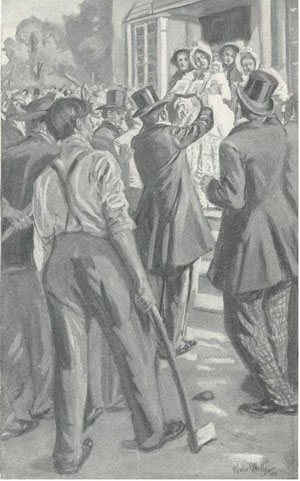On March 10, 1850 St. Patrick’s Church was dedicated with elaborate ceremonies by Bishop Hughes. Contemporary newspaper accounts described it as “perhaps, the most ornamental church edifice…and the most striking specimen of the Gothic style in the State.” Its 200-foot high spire, topped with a cross, rose over the entrance to a church 130 feet long, 70 feet wide, with a ceiling 60 feet high. Light filtered through stained glass windows. The most impressive one, over the altar, depicted “the savior in the attitude of addressing the people.” In an 1852 report, Senez noted that the total cost of the church was “about $25,000,” an enormous sum in those days for a poor parish. Father Senez’s salary as pastor was $50 per month. St. Patrick’s Parish included all of Newark from Belleville to the south end of the city, west to Orange, with the exception of St. Mary’s German parish. It embraced the town of Harrison as well.

From Joseph Flynn,
The Catholic Church in New Jersey
A school building was begun early in July 1851, finished by the contractor late in the fall, and occupied before the winter season of 1851-1852. In it, the parish conducted a Day and Sunday School. An Orphan Asylum for about a dozen children was established in the school dormitory in the winter of 1851-2. Beds were put in the dormitory where the pastor had four rooms fitted up for his own residence. There was ample space for the little family, which increased to 23 in 1852. The orphans were supervised by a few charitable young women who also schooled them. When four of the children were stricken with smallpox in the epidemic of 1852, Father Senez refused to allow any of the teachers to sit up nights. He did the night nursing himself. All the children recovered.
The Irish immigrants whom St. Patrick’s served were not welcomed by many of their fellow citizens. The generous Mr. Norris, who helped Father Moran secure the property, did not represent the majority. The American Party, called the “Know-Nothings” Party, which advocated violence against Catholics and all immigrants, was strong in New Jersey. It was hailed by one Newark newspaper as “a friend of order.” In nearby Elizabethtown, Know-Nothings marched on St. Mary’s Catholic Church with the intention of destroying it. The pastor, the Rev. Isaac P. Howell, to avoid bloodshed, sent the men of the parish away and asked the women to come to the church with their children. Mrs. Mary Whelan stood in the doorway, her baby in her arms, and told the leader of the mob that he would have to kill her and her child before he could pass. Humiliated, he turned on his followers and swore he would “brain the first man” who laid a finger on Mrs. Whelan. The mob dispersed.